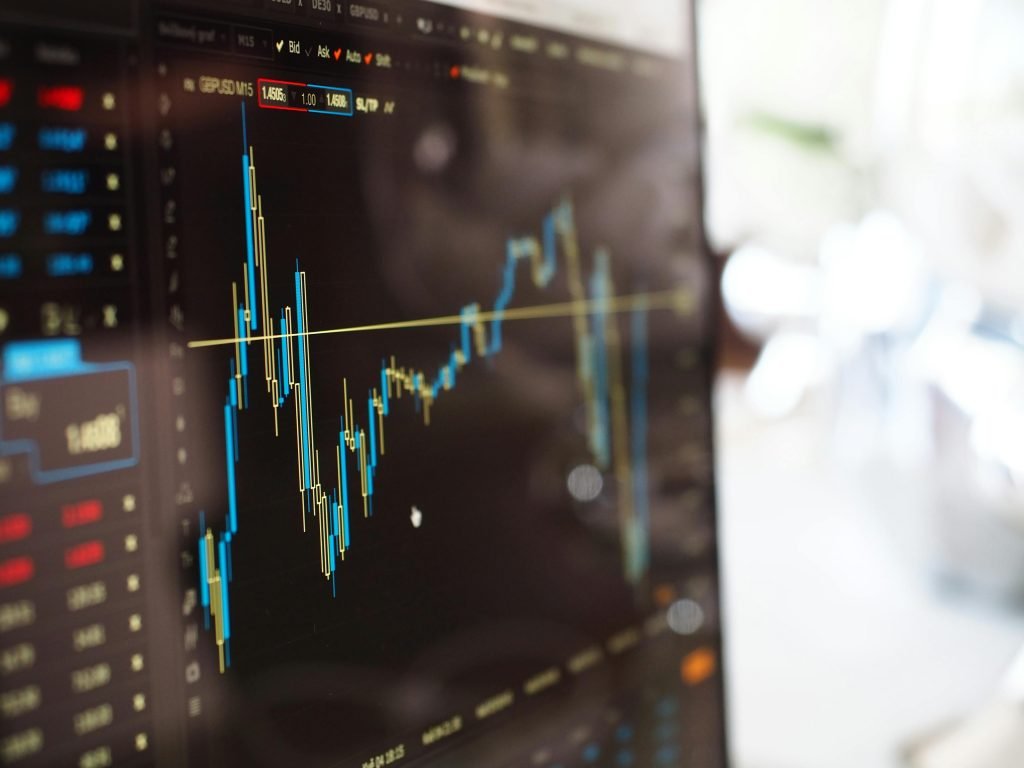How to earn $1000 per day in Trading: Beginner’s Guide 2024-25

Introduction to Trading
Trading in financial markets has grown immensely in popularity, attracting people from all walks of life. It can be a potentially lucrative venture but also comes with significant risks. Whether you’re looking to trade stocks, forex, cryptocurrencies, or commodities, the right knowledge and strategies are critical for success. In this guide, we’ll take you through every step to start trading, providing you with the foundation necessary to navigate the complexities of the market.
Understanding Financial Markets
Before diving into trading, it’s essential to understand what financial markets are and how they operate. Broadly, financial markets refer to places where assets are bought and sold. These assets can include stocks, bonds, commodities, forex (foreign exchange), and more. Each market operates differently, and as a beginner, you should choose the one that aligns with your goals and interests.
- Stock Market: Involves buying and selling shares of companies. When you purchase a share, you own a part of that company.
- Forex Market: The trading of currencies, where traders profit from fluctuations in currency values.
- Trading physical assets such as gold, oil, or agricultural products is known as the commodities market.
- Cryptocurrency Market: Trading digital assets like Bitcoin, Ethereum, and other altcoins.

Choosing the Right Trading Style
Not all traders operate the same way. The type of trader you want to become will depend on your goals, time commitment, and risk tolerance. Below are common trading styles:
- Day Trading: Traders who open and close trades within the same day, focusing on short-term price movements. Requires a lot of attention and time.
- Swing Trading: This style involves holding positions for several days to weeks, capturing medium-term price swings. It’s less demanding than day trading but still requires careful analysis.
- Holding trades for several months or even years is known as position trading. Position traders focus on long-term trends and ignore short-term fluctuations.
- Scalping: A very fast-paced form of day trading where traders look to make small profits from quick trades executed in seconds or minutes.
- Algorithmic Trading: Using computer programs or algorithms to automatically execute trades based on predefined criteria.

Setting Your Trading Goals
Before you start trading, clearly define your objectives. Are you trading to build long-term wealth, or are you looking for quick profits? Your goals will determine your strategy, risk management, and the types of assets you trade. Be realistic about the time and resources you can devote to trading. Having clear goals helps you stay focused and avoid emotional decisions.
Learning the Basics: Key Concepts and Terminology
- Bid/Ask Price: The bid is the highest price a buyer is willing to pay for an asset, while the ask is the lowest price a seller is willing to accept.
- The spread is the amount that separates the ask and bid prices.
- Leverage: Taking out a loan to raise your possible return on investment. However, it also increases risk.
- Margin: The amount of capital required to open a position. Trading on margin involves borrowing money from your broker to trade more than you could with just your funds.
- Pips: In forex trading, a pip is the smallest price move that can occur in a currency pair.
- Lots: A standard unit of trading. For forex, a standard lot is 100,000 units of the base currency.
- Stop-Loss Order: An order to sell an asset when it reaches a specific price to limit potential losses.
- Take-Profit Order: An order to close a trade at a predetermined profit level.

Choosing a Trading Platform
Technical analysis, market monitoring, and trade execution will all be done on the platform. Popular trading platforms include MetaTrader 4/5, Thinkorswim, and TradingView.
Factors to consider when choosing a platform:
- Ease of Use: For beginners, a user-friendly platform is essential. Look for platforms with intuitive designs and helpful features.
- Technical Analysis Tools: Charting and analysis tools are vital for making informed decisions.
- Order Execution: Ensure the platform provides fast and reliable order execution.
- Support and Resources: Does the platform offer customer support, tutorials, or educational resources?
- Mobile Access: A platform with a mobile version allows you to trade on the go.

Choosing a Broker
A broker serves as a go-between for you and the financial industry. There are many brokers to choose from, and your selection should be based on several key factors:
- Regulation: Verify that a respectable financial authority oversees the broker. This provides a level of protection for your funds.
- Fees and Commissions: Brokers charge fees for each trade. These can be commission-based, fixed-fee, or a spread between the buy and sell price. Choose a broker with competitive pricing.
- Leverage and Margin: Some brokers offer higher leverage, which can amplify both profits and losses. Choose leverage levels that fit your risk tolerance.
- Account Types: Many brokers offer different account types, including demo accounts where you can practice trading with virtual funds.
- Customer Support: Quality customer service is important, especially when technical issues arise.

Building a Trading Plan
A well-structured trading plan is the foundation of success in trading. It helps you stay disciplined and stick to a set of rules, rather than making decisions based on emotions.
Key components of a trading plan:
- Establish the terms under which you will enter and leave trades by defining your entry and exit criteria. This could be based on price levels, technical indicators, or market conditions.
- Position Sizing: Determine how much you are willing to risk on each trade. Risking more than 1-2% of your trading capital on a single trade is generally considered too high.
- Risk management: To safeguard your money, use risk management techniques including stop-loss orders.
- Profit Targets: Establish profit targets based on realistic expectations. This helps prevent over-trading or holding onto losing positions.

Risk Management
In trading, risk is inevitable, but managing it effectively can keep you in the game longer and improve your chances of success.
- Diversification: Don’t put all your eggs in one basket. Diversify across assets and markets to spread risk.
- Position Sizing: As mentioned, never risk too much on a single trade. Adjust position size based on your overall capital.
- Stop-Loss Orders: For every trade, always place a stop-loss order. It automatically closes your position when the market reaches a certain level, preventing significant losses.
- Avoid Overleveraging: While leverage can boost profits, it can also magnify losses. Be conservative with your use of leverage.

Technical vs. Fundamental Analysis
Fundamental and technical analyses are two primary approaches for evaluating investments and making trading decisions, each with distinct methodologies.
Key Differences:
- Fundamental Analysis examines an asset’s intrinsic value by analyzing economic and financial factors, such as company performance, industry trends, and economic indicators. It aims to identify undervalued assets for long-term investment.
- Technical Analysis focuses on price action and volume data over time, utilizing historical price movements and patterns to predict future trends. It operates on the belief that market psychology influences price changes.
Fundamental Analysis
- Objective: Assess intrinsic value through financial statements, economic indicators, and qualitative factors like management quality.
- Main Tools: Financial statements (income statements, balance sheets), economic indicators (GDP, interest rates), and news/events.
- Criticisms: Time-consuming, subjective interpretations, lagging information, and difficulty quantifying qualitative factors.
Technical Analysis
- Objective: Analyze price movements and trading volumes to forecast future prices.
- Main Tools: Technical indicators (momentum, mean reversion), volume analysis, relative strength, and chart patterns (candlestick, support/resistance).
- Criticisms: Skepticism regarding market efficiency, subjective interpretations, and reliance on historical data.
Pros and Cons:
| Fundamental Analysis | Technical Analysis |
|---|---|
| In-depth understanding of financial health | Timely decisions based on real-time data |
| Long-term focus | Simplicity and graphical representation |
| Considers qualitative factors | Provides psychological insights |
| Adaptable to various asset classes | Adaptable to various asset classes |
| Time-consuming and subjective | Subjective interpretations and potential false signals |
Blending Both Approaches
Many investors combine fundamental and technical analyses to leverage their strengths while mitigating weaknesses. For instance, fundamental analysis can identify an asset’s intrinsic value, while technical analysis can determine optimal entry and exit points. This blended approach offers a comprehensive understanding and effective strategies for both short- and long-term investments, although it requires substantial knowledge and effort.
Ultimately, understanding both methods equips traders and investors to navigate the financial markets more effectively.

Formulating a Trading Plan
A trading strategy outlines the specific approach you will take when trading. Your strategy should be built around your trading style, risk tolerance, and analysis method. Some popular strategies include:
- Trend Following: Identifying long-term market trends and trading in the direction of those trends.
- Breakout Trading: Involves buying when the price breaks above a key resistance level or selling when it breaks below a support level.
- Reversal Trading: Focuses on identifying when a trend will reverse and profiting from the change in direction.
- Range Trading: Buying at support and selling at resistance when the market is trading in a range (sideways movement).

Emotional Control in Trading
Emotional regulation is essential for successful trading, as the volatility of financial markets can trigger emotional responses that impair judgment. Key emotional biases include fear of loss, greed for excessive profits, regret over past mistakes, and confirmation bias, which can all lead to poor decision-making.
Strategies for Emotional Regulation:
- Mindfulness and Meditation: Increases awareness of thoughts and emotions, helping to manage them effectively.
- Journaling: Aids in processing emotions and recognizing behavioral patterns.
- Time Management: Allows for thorough preparation, reducing the likelihood of rushed decisions.
- Set Realistic Goals: Helps prevent disappointment and frustration.
- Limit Screen Time: Reduces stress from constant market updates.
- Seek Support: Engaging with mentors or therapists provides valuable guidance.
- Practice Self-Care: Focuses on physical and mental well-being through healthy habits.
Developing a Trading Plan: A solid trading plan should include entry and exit criteria, risk management strategies, and emotional management guidelines to help traders remain disciplined and focused.

The Importance of Continual Learning
The financial markets are constantly changing, and staying informed is key to remaining competitive. Whether you’re new to trading or have years of experience, continual learning is a must.
- Read Books and Articles: Many books and articles can help deepen your understanding of trading strategies, psychology, and market dynamics.
- Attend Webinars and Courses: Professional traders often host webinars and courses that provide valuable insights and education.
- Join Trading Communities: Online forums, social media groups, and trading communities offer a wealth of information and support. They can help you stay motivated and learn from others’ experiences.

Utilizing a Demo Account for Practice
A trading demo account is a practice account offered by online trading platforms that allows users to test the platform’s features and trade in a simulated environment without using real money. Demo accounts are available for stock, forex, commodities, and crypto trading.
Key Benefits:
- Provides a risk-free way to explore trading tools and features.
- Allows traders to practice strategies under real-time market conditions.
- Helps experienced traders test new markets like forex or commodities.
How It Works: Traders use simulated funds to buy and sell assets, mirroring real market conditions without risking capital.
Choosing a Demo Account: Look for platforms that offer real-time data, user-friendly interfaces, and the specific markets you’re interested in, like forex, stocks, or crypto. Popular platforms include TD Ameritrade’s TickerTape.

Making the Switch to Live Trading
Transitioning from paper trading to live trading is a critical step that requires preparation and discipline. Here’s a concise guide:
- Master the Basics: Understand fundamental analysis (market news, economic trends) and technical analysis (charts, patterns). Develop risk management strategies.
- Build a Trading Plan: Define goals, choose a trading strategy, and set rules for trade execution and risk management.
- Practice with Simulated Trading: Continue paper trading and backtesting to refine your approach.
- Choose a Broker: Select a broker that meets your needs, offers useful tools, and has reasonable fees.
- Open a Live Account: Fund your account and start small to manage risk.
- Stick to Your Plan: Follow your established rules and avoid emotional decisions.
- Continuously Learn: Stay informed about market trends and regularly review your performance.
- Seek Guidance: Consider finding a mentor or joining a trading community for support.

Monitoring Your Development: The Value of Keeping a Trading Journal
A trading journal is an essential tool for traders to track, analyze, and improve their trading activities. By maintaining a detailed record of each trade, traders can gain insights into their performance, identify strengths and weaknesses, and improve decision-making.
Key Benefits:
- Tracking Performance: Monitor profitability and losses to identify trends.
- Identifying Strengths/Weaknesses: Pinpoint areas for improvement.
- Understanding Psychology: Recognize emotional biases affecting decisions.
- Developing a Plan: Create a more effective trading strategy.
- Improving Risk Management: Refine risk management strategies.
What to Include:
- Date, time, entry/exit prices, quantity, reason for entry, stop-loss/take-profit levels, results, and analysis.
Tips:
- Be consistent, honest, and specific, use a template, and review regularly.

Comprehending Regulations and Taxes
Regulations and taxes play a crucial role in governing business and personal finances.
- Regulations: These are government-imposed rules to ensure fairness and safety. Key types include:
- Business Regulations: Cover licensing, labor laws, and environmental standards.
- Industry-Specific Regulations: Focus on sectors like finance or healthcare.
- Tax Regulations: Govern tax collection and payments.
- Taxes: These are mandatory payments to fund public services. Common types include:
- Income Taxes: Levied on individual and corporate earnings.
- Sales Taxes: Applied to goods and services.
- Property and Capital Gains Taxes: Charged on real estate and asset profits.
Key Considerations:
- Compliance with regulations and tax laws is essential to avoid penalties.
- Seek professional advice for navigating complex tax laws and optimizing tax planning.
- Stay updated on tax reforms and regulation changes that may impact your obligations.

Advanced Trading Methods and Approaches
Advanced trading techniques and strategies are designed to help traders make informed decisions and manage risk more effectively. Here are some key strategies:
1. Technical Analysis:
- Elliott Wave Theory: Identifies market patterns based on wave cycles to predict trends.
- Fibonacci Retracements: Helps find support/resistance levels using Fibonacci numbers.
- Chart Patterns: Recurring shapes like head and shoulders or triangles signal future price moves.
- Volume Analysis: Analyzing trading volume to gauge market sentiment and trend strength.
2. Quantitative Trading:
- Algorithmic Trading: Uses computer programs to automate trades based on preset rules.
- High-Frequency Trading (HFT): Executes trades rapidly to capitalize on small price differences.
- Statistical Arbitrage: Exploits price discrepancies between related securities.
3. Options Strategies:
- Covered Calls: Selling calls on owned stocks to generate income.
- Protective Puts: Buying puts to guard against price drops.
- Straddles/Strangles: Profiting from volatility by purchasing both calls and puts.
4. Risk Management:
- Stop-Loss/Take-Profit Orders: Automatically sell positions at specific loss/profit points.
- Position Sizing: Allocating capital based on risk tolerance and potential rewards.
- Hedging: Reducing risk by taking offsetting positions in different securities.
5. Other Strategies:
- Arbitrage: Profiting from price discrepancies between markets.
- Fundamental Analysis: Evaluating a company’s financial health and industry trends.
- News Trading: Reacting to market-moving news events.
Considerations:
Risk management, education, and access to the right tools and technology are crucial when applying these advanced techniques.

Preventing Typical Trading Errors
Here are five typical trading errors and tips for avoiding them:
1. Emotional Trading: Making bad decisions stems from allowing emotions such as fear or greed to rule the situation. When a position goes against you, panicking could lead to rash purchases or sales. Rather than reacting hastily, adhere to a well-thought-out plan and concentrate on risk management.
2. Moving the Goal Posts: Adjusting indicators or stop-losses to avoid acknowledging a loss frequently results in larger losses. Remain true to your initial plan and exit losing positions as soon as you see fit, rather than sticking to them.
3. Playing Earnings: Even if you believe you have a good sense of a stock’s future, trading around earnings can be unpredictable. Because market responses to earnings announcements often surprise observers, it is safer to stay out of the market during these erratic times.
4. Trading the Wrong Time Frame: Making bad decisions might result from trading at a tempo that is too quick or too sluggish for your personality. Choose a time frame that corresponds with your temperament to enable you to trade with greater confidence and clarity.
5. Attempting to Predict Tops or Bottoms: Recognizing the precise top or bottom of the market is a very challenging task that is overly focused on by many traders. Rather, it’s frequently more beneficial to follow patterns and steer clear of needless risks by attempting to forecast extremes. Pay more attention to steady progress than spectacular tales.

Conclusion
Beginning a trading career may be thrilling and difficult at the same time. By educating yourself, developing a solid trading plan, and practicing discipline, you can navigate the complexities of the market and increase your chances of success. Whether you’re day trading, swing trading, or investing for the long term, the key to success lies in continuous learning, strategic planning, and proper risk management.
FAQs :
1. What is trading?
Trading involves buying and selling financial instruments, such as stocks, currencies, or commodities, with the aim of making a profit from price fluctuations.
2. What is the minimum amount of money required to begin trading?
No, you can start trading with a small amount of capital, especially with brokers that offer fractional shares or low minimum deposits. However, starting small is recommended to minimize risk.
3. What is a trading strategy?
A trading strategy is a plan that outlines how you will enter and exit trades based on specific criteria, including market conditions and your risk tolerance.
4. What are the different types of trading?
Common types of trading include day trading (buying and selling within the same day), swing trading (holding positions for several days or weeks), and long-term investing (holding positions for months or years).
5. How do I choose a broker?
Consider factors such as fees, trading platform, available assets, customer support, and whether the broker is regulated by a reputable authority when choosing a broker.
6. What is a demo account?
A demo account allows you to practice trading with virtual money, helping you familiarize yourself with the trading platform and test strategies without risking real funds.
7. How do I manage risk while trading?
Implement risk management strategies such as setting stop-loss orders, diversifying your portfolio, and only risking a small percentage of your capital on each trade.
8. Can I trade part-time?
Yes, many traders trade part-time while maintaining other jobs or commitments. You can choose a trading style that fits your schedule, such as swing trading or position trading.



